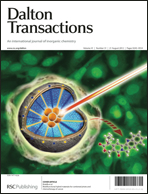Structural, spectroscopic, and electrochemical properties of tri- and tetradentate N3 and N3S copper complexes with mixed benzimidazole/thioether donors†
Abstract
Cupric and cuprous complexes of bis(2-methylbenzimidazolyl)(2-methylthiophene)amine (L1), bis(2-methylbenzimidazolyl)benzylamine (L2), bis(2-methylbenzimidazolyl)(2,4-dimethylphenylthioethyl)amine (L3), bis(1-methyl-2-methylbenzimidazolyl)benzylamine (Me2L2), and bis(1-methyl-2-methylbenzimidazolyl)(2,4-dimethylphenylthioethyl)amine (Me2L3) have been spectroscopically, structurally, and electrochemically characterised. The thioether-containing ligands L3 and Me2L3 give rise to complexes with Cu–S bonds in solution and in the solid state, as evidenced by UV-vis spectroscopy and X-ray crystallography. The Cu2+ complexes [L1CuCl2] (1), [L2CuCl2] (2) and [Me2L3CuCl]ClO4 (3Me,ClO4) are monomeric in solution according to ESI mass spectrometry data, as well as in the solid state. Their Cu+ analogues [L1Cu]ClO4, [L2Cu]ClO4, [L3Cu]ClO4 (4–6), [BOC2L1Cu(NCCH3)]ClO4 (4BOC), [Me2L2Cu(NCCH3)2]PF6 (5Me) and [Me2L3Cu]2(ClO4)2 (6Me) are also monomeric in acetonitrile solution, as confirmed crystallographically for 4BOC and 5Me. In contrast, 6Me is dimeric in the solid state, with the thioether group of one of the ligands bound to a symmetry-related Cu+ ion. Cyclic voltammetry studies revealed that the bis(2-methylbenzimidazolyl)amine-Cu2+/Cu+ systems possess half-wave potentials in the range −0.16 to −0.08 V (referenced to the ferrocenium–ferrocene couple); these values are nearly 0.23 V less negative than those reported for related bis(picolyl)amine-derived ligands. Based on these observations, the N3 or N3S donor set of the benzimidazole-derived ligands is analogous to previously reported chelating systems, but the electronic environment they provide is unique, and may have relevance to histidine and methionine-containing metalloenzymes. This is also reflected in the reactivity of [Me2L2Cu(NCCH3)2]+ (5Me) and [Me2L3Cu]+ (6Me) towards dioxygen, which results in the production of the superoxide anion in both cases. The thioether-bound Cu+ centre in 6Me appears to be more selective in the generation of O2˙− than 5Me, lending evidence to the hypothesis of the modulating properties of thioether ligands in Cu–O2 reactions.


 Please wait while we load your content...
Please wait while we load your content...